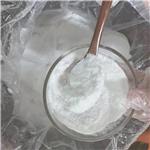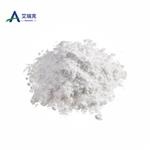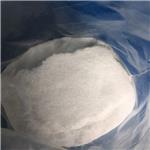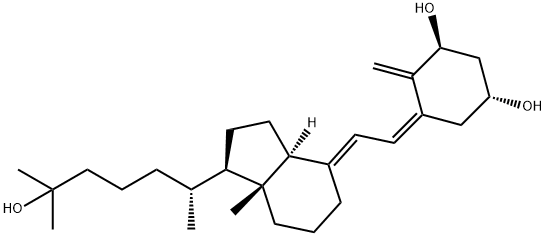Calcitriol: Activity, Mechanisms, Application, Toxicity and Contraindications Studies
Mar 1,2023
General Description
Calcitriol (1α,25(OH)2D3), the hormonally active form of vitamin D3 (D3)is produced by a cascade of reactions, It is well established that vitamin D3, mainly produced in the skin, and dietary vitamin D3 are metabolized first in the liver to 25-hydroxyvitamin D3 (25OHD3, calcidiol) and then in the kidney to calcitriol. There is substantial evidence for additional extrarenal sites of calcitriol synthesis. In vitro, many nonrenal cells, including bone, placenta, prostata, keratinocytes, macrophages, T-lymphocytes and several cancer cells (e.g., from lung, prostata and skin) can enzymatically convert calcidiol (25OHD3) to Calcitriol.[1]

Figure 1 Calcitriol powder
Activity
Calcitriol is a hormonally-active, synthetic vitamin D analog prescribed to treat hypocalcemia, osteoporosis, and the prevention of corticosteroid-induced osteoporosis.[2]
Mechanisms
Systemically, calcitriol binds to vitamin-D receptors in the kidneys, parathyroid glands, intestines, and bones to increase serum blood calcium levels by promoting absorption in the intestines, renal tubular reabsorption in the kidneys, and release from bone. Calcitriol serves as a transcription factor to encode a calcium-binding protein, which simultaneously transports calcium and phosphate ions across intestinal epithelial cells.[3] Along with parathyroid hormone, calcitriol stimulates bone resorption by activating osteoclasts through the release of receptor activator of nuclear factor kappa-B ligand (RANKL) from osteoblasts. Topically, studies have found that calcitriol significantly inhibits the proliferation of normal human epidermal keratinocytes and T lymphocytes by inducing apoptosis, as well as inhibiting gene expression of relevant chemokines and epidermal proteins involved in psoriasis.[4]
The mechanisms of action behind the enhancing properties of calcitriol upon radiation therapy in BC cells :1.Induction of cytotoxic autophagy; 2.Reduction of RelB. One way by which calcitriol improves the prognosis of patients with BC is by inhibiting RelB expression, with in turn downregulates Bcl-2 and increases BC cell sensitivity to gamma-irradiation.3.Sensitization of BCSCs to ionizing radiation through the inhibition of the Wnt/β-catenin signaling pathway;4.Enhancement of the antiproliferative and apoptotic effects of ionizing radiation.[5]
Application
Systemic calcitriol is FDA indicated to control hypocalcemia in patients on chronic renal dialysis, secondary hyperparathyroidism in those with chronic kidney disease not yet on dialysis, and hypocalcemia in patients with hypoparathyroidism and pseudohypoparathyroidism. In 2009, the FDA approved topical calcitriol ointment for the management of mild to moderate plaque psoriasis. Off-label uses for systemic calcitriol include type 1, vitamin D-dependent rickets, and pseudo-vitamin D deficiency rickets. Off-label use of topical calcitriol ointment includes psoriasis in children and adolescents.The calcitriol and its synthetic analog calcipotriol can upregulate ERα expression in a subset of ER-negative breast cancer cells, and this may offer a therapeutic alternative, particularly in those patients affected with ER-negative tumors by sensitizing them to hormone therapy, with the aim at improving disease prognosis.[2]Most cancer cells can respond to calcitriol by expressing the VDR. In particular, BC cells have shown higher VDR protein levels compared to benign breast tissue. Through this transcription factor, calcitriol exerts many anticancer effects, including growth inhibition, induction of cell differentiation, anti-inflammatory activity, cell cycle arrest, oncogenes downregulation, and many others that place calcitriol as a natural endogenous cancer-preventive antineoplastic factor. Notably, calcitriol not only acts as an antineoplastic agent, but also can help to overcome drug resistance, increase the susceptibility to chemotherapy and even potentiate the effects of conventional chemotherapeutic agents and radiation therapy.[6]In addition, Calcitriol may have the potential to improve the clinical responsiveness of asthma patients to systemic steroid therapy in SR asthma.[7]
But, calcitriol is administered intravenously through a catheter, orally without regard to meals, and topically for external use only. For intravenous administration, no dilution is necessary, and a bolus dose is given at the end of a hemodialysis session. During the initial titration period, serum calcium and phosphorous levels should be monitored twice weekly. Calcitriol capsules and oral solutions may be taken with or without meals but should be protected from prolonged light exposure. Topical administration is performed by applying a thin film to the affected area with gentle rubbing, being careful not to apply to the face or eyes.[8]
Toxicity
Hypercalcemia is the most common adverse reaction reported in at least one-third of patients taking systemic calcitriol. Early signs of hypercalcemia include fatigue, weakness, nausea, vomiting, abdominal pain, constipation, diarrhea, vertigo, tinnitus, ataxia, arthralgia, and irritability.[9]Less than 1% of post-marketing case reports have found pruritus, erythema, acute generalized exanthematous pustulosis, psoriasis, and contact dermatitis to be associated with calcitriol ointment.[10]
Contraindications
Hypercalcemia, vitamin D toxicity, and hypersensitivity to calcitriol or any vitamin D analog are relative contraindications to taking systemic calcitriol. Further contraindications to calcitriol are patients with increased sensitivity to calcium dysregulation, including arteriosclerosis, cardiac disease, hyperphosphatemia, renal failure, and sarcoidosis. Patients with cardiac disease, especially those taking digoxin, are at an increased risk for cardiac arrhythmias from hypercalcemia and should be dosed conservatively.[11]
Patients with renal failure are susceptible to increased risk for vitamin D-induced hypercalcemia, and chronic hypercalcemia may lead to soft tissue calcification, nephrocalcinosis, and other toxicities.From a preventative lifestyle perspective, accidental exposure, prolonged ultraviolet (UV) sunlight absorption, occlusive dressing use, ocular exposure, and dehydration are contraindications to calcitriol use, as they may increase serum calcium to toxic levels. Photosensitizing agents and UV sunlight may increase the risk of skin tumor formation when combined with topical calcitriol. The topical ointment should not be applied to the face and may lead to skin irritation. For patients with recent injuries and wounds, increased calcium levels may also occur with topical administration due to the enhanced absorption of calcitriol from occlusive dressings.Pregnancy and breastfeeding are also contraindications to calcitriol administration.[2]Further contraindications and considerations to calcitriol administration include major drug interactions that are known to induce hypercalcemia. Concomitant use of thiazides and calcitriol can worsen hypercalcemia as thiazides help reabsorb calcium at the distal tubule.[12]
References
[1]Lehmann B, Meurer M. Extrarenal sites of calcitriol synthesis: the particular role of the skin[J]. Vitamin D Analogs in Cancer Prevention and Therapy, 2003: 135-145.
[2]Lung B E,et al.Calcitriol[J]. 2018.
[3].Barminko J,et al. Activation of the vitamin D receptor transcription factor stimulates the growth of definitive erythroid progenitors[J]. Blood Adv.2018,2(11):1207-1219.
[4].Al-Dhubaibi MS. Association between Vitamin D deficiency and psoriasis: An exploratory study[J].Int J Health Sci (Qassim).2018,12(1):33-9.
[5]Segovia-Mendoza M,et al. Combinations of Calcitriol with Anticancer Treatments for Breast Cancer: An Update[J].Int J Mol Sci. 2021;22(23):12741.
[6]Santos-Martínez,et al. Calcitriol restores antiestrogen responsiveness in estrogen receptor negative breast cancer cells: A potential new therapeutic approach[J].BMC Cancer. 2014,4:230.
[7]Nanzer, A. M. The calcitriol study: A randomised placebo controlled clinical trial to test the effects of calcitriol in steroid resistant asthma[J]. ProQuest Dissertations Theses Global.2015
[8]Santos-Martínez,et al. Calcitriol restores antiestrogen responsiveness in estrogen receptor negative breast cancer cells: A potential new therapeutic approach[J].BMC Cancer. 2014,4:230.
[9]Zhou L, et al. Extreme hypercalcaemia due to accidental vitamin D intoxication[J].Paediatr Child Health.2019 ,55(1):104-106.
[10]Yip KH, et al.Mechanisms of vitamin D? metabolite repression of IgE-dependent mast cell activation[J].Allergy Clin Immunol.2014,133(5):1356-64, 1364.e1-14.
[11]Kota BP,et al.Effect of vitamin D3 supplementation on the pharmacokinetics of digoxin--a pilot study[J].Fundam Clin Pharmacol.2012, 26(4):543-8.
[12]Karras SN, et al. Understanding vitamin D metabolism in pregnancy: From physiology to pathophysiology and clinical outcomes[J].2018, 86:112-123.
- Related articles
- Related Qustion
- Calcitriol: Function, Mechanism of Action and Side Effects May 6, 2024
Calcitriol is an active metabolite of vitamin D and a vitamin D receptor (VDR) agonist.
- The Mechanism of Calcitriol in Cancer Treatment Jan 30, 2024
Calcitriol regulates cell cycle, induces apoptosis, and promotes cell differentiation, contributing to its anti-cancer effects.
- Biological function and synthesis of Calcitriol Jun 17, 2022
Calcitriol is a calciotropic hormone secreted by renal proximal tubular cells. It stimulates intestinal calcium absorption and bone mineralization.
Carbon is the 15th most abundant element in the Earth's crust, and the fourth most abundant element in the universe by mass after hydrogen, helium, and oxygen. Carbon's abundance, its unique diversity of organic compounds, and its unusual a....
Feb 28,2023Inorganic chemistryBtk Kinase inhibitor is highly potent and selective orally administered, small molecule. It was approved in Japan for the treatment of recurrent or refractory primary central nervous system lymphoma.....
Mar 1,2023APICalcitriol
32222-06-3You may like
- Calcitriol
-

- $3.00 / 1kg
- 2024-04-12
- CAS:32222-06-3
- Min. Order: 1kg
- Purity: 99.9%
- Supply Ability: 10 tons
- Calcitriol
-

- $0.00 / 1Kg
- 2024-04-03
- CAS:32222-06-3
- Min. Order: 1Kg
- Purity: 99.9%
- Supply Ability: 20tons
- Calcitriol
-

- $35.00/ kg
- 2024-03-12
- CAS:32222-06-3
- Min. Order: 1kg
- Purity: 99.8%
- Supply Ability: 200tons/year




